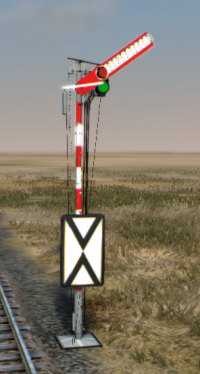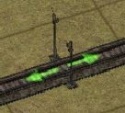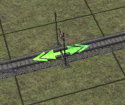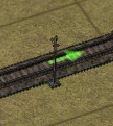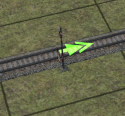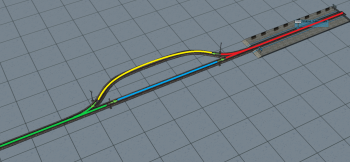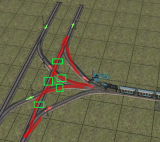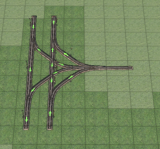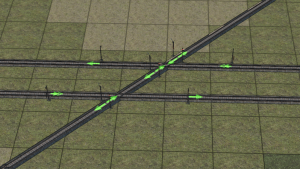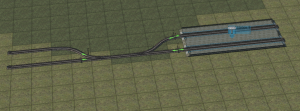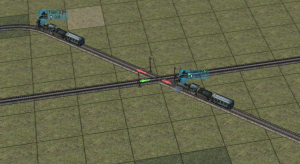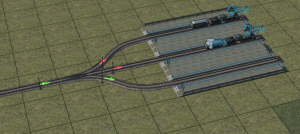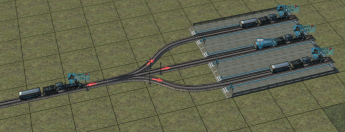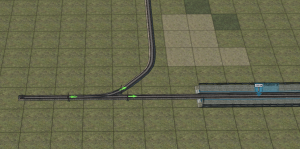Difference between revisions of "Signals"
(→Chain signals explained: removing advanced example that has no place in a section teaching the core function - it's just confusing newcomers) |
|||
| Line 20: | Line 20: | ||
(side of the track we clicked on will determine the orientation of the one way signal) | (side of the track we clicked on will determine the orientation of the one way signal) | ||
| − | Signals cannot be placed | + | Signals cannot be placed at station platforms and directly on railway intersections. Signals are hard to place in tunnels, but you can get around this by using the multi-signal tool: it will space signals correctly to allow for efficient use of longer tunnels. (It is admittedly hard to delete those signals without deleting the whole expensive tunnel though) |
<!-- i will fix the picture dimensions later + want to add some picters of two way and one way signal in use --> | <!-- i will fix the picture dimensions later + want to add some picters of two way and one way signal in use --> | ||
Revision as of 11:32, 12 July 2021
Game Manual
- Basics
- Game content
- Infrastructure
- Vehicles
Contents
Purpose
Signals prevent trains from crashing into each other while driving on the same track and it is for this reason that they are an important part of any railway system - safety first guys!
A signal divides a railway line into two sections known as blocks. If a block is occupied by a train then the signal dividing these blocks won't allow any other train to enter that occupied block until this block is cleared.
Placing of signals
one left mouse button click = two way signal will be placed on a railway track
second left mouse button click on the same signal = two way signal will be transformed to one way signal
(side of the track we clicked on will determine the orientation of the one way signal)
Signals cannot be placed at station platforms and directly on railway intersections. Signals are hard to place in tunnels, but you can get around this by using the multi-signal tool: it will space signals correctly to allow for efficient use of longer tunnels. (It is admittedly hard to delete those signals without deleting the whole expensive tunnel though)
Different kinds of signals:
Block signals explained
Block signals allows access only on the blocks which are not occupied by other train. Block is the space of railway between two signals. You can see the block status with the arrows pointing towards the segments. Red arrow means that the block in the arrow direction is occupied.
Block signals basics
On the right picture you can see our example station situation. Each block is located between two signals / end of the track and colored with different color. Red is the station block, blue is the entry block, green is the rest of the track. Yellow track is the exit from station. This way, one train can approach the station from the left while another train can leave from the station.
You can notice that the station block is now split into two tracks with two one-way singal. One "entrance" signal, one "exit" signal. The incoming train will enter from the green block to blue block. Then the train enters the station, the red block. Next incoming train will have red sign on the entrance signal, because of occupied red block and it will wait in the blue block, while the first train will have space to leave through the yellow block. This is effective enough on the low load railroads.
Common mistakes
| Image | Information |
|---|---|
| |
Crossings with not enough signals - the whole red area is single block and can be occupied by only one train. That will make that crossing very ineffective. For it to work better, there need to be 6 more signals (marked by green rectangles) |
| |
As practical example of the Not enough signals, train could block itself in such block. For this train to move at all, there must be more signals placed in marked rectangles. |
Correct signals
| Image | Information |
|---|---|
| Trains at both intersections will run correctly. They will not block the intersection and the ride will be smooth. | |
| Trains at both intersections will run correctly. They will not block the intersection and the ride will be smooth. |
For more examples of intersections, see Junctions page.
Correct use of bi-directional signals
To prevent trains from getting stuck nose-to-nose at bi-directional signals, they have to be placed very carefully. There are basically only two situations where they should be used:
- Side line with single track and only one train going back and forth crossing the main line. Without the crossing, there wouldn't have to be any signals on such side line. But to prevent above described self-block, there must be signals on each segment. Since the track is used in both directions by one train only, these must be bi-directional signals. If there is more than one train using such sideline, bridge must be used instead of the crossing otherwise the trains would get stuck nose-to-nose at the bi-directional signal eventually.
- End station with multiple platforms (no trains entering the station from the other end). If you send more trains than the number of platforms, there must be chain signal at the entry switch, where the next train will wait, if all platforms are occupied.
Chain signals explained
Definition
Chain signal will be green if there is at least one green signal behind it.
While it sounds complicated, it simply means that the signal will "look" down the line at the next signal (or signals if there is a switch and multiple tracks) and if it sees all red, it will be red, if it sees at least one green, it will turn green.
It should be noted that incorrectly placed chain signal where block signal should be will not cause an accident, but it will make the trains wait longer, thus the rail network will be less efficient as a whole.
Correct use
There are three main situations where chain signals are needed:
- At crossings to prevent train from blocking the crossing, if the train cannot continue beyond it. Correctly placed signals are Chain before the crossing and Block after the crossing. If the track after the crossing is empty -> the block signal is green -> the chain signal before the crossing is green. If the block after the crossing is occupied -> the block signal is red -> the chain signal before the crossing is red as well so next train won't enter the crossing thus it will not block the traffic on the other track. For instance, imagine the upper left track leading to an off-screen loading station, and the first train is waiting its turn. The second train will not enter the crossing (and block it) while it waits behind the first train, thanks to the chain signal.
- At the switch where train can choose any tracks and should wait for the first available, if all of the tracks are occupied. Most common use is at multi-platform stations (assuming all platforms are equal, i.e. every track leads on to every possible destination). Take this three-track station below. Imagine all three tracks being occupied and a fourth train arriving. Without the chain signal, the fourth train would choose one station track, and enter it stopping until the train of that track leaves the station. Even if both the other two trains leaves the station first, this fourth train has already chosen its track, and will wait until that track becomes available. While it does so, it blocks the junction and therefore all traffic. With a chain signal instead, the train will stop before the junction, and once any track becomes available, the train will choose that track. This is obviously more efficient and removes a common source of blocked stations.
- Terminal stations. Wherever you use bi-directional signals on a stretch of track used by more than a single train, you need chain signals to avoid trains eventually getting stuck nose-to-nose.
Common mistakes
- placing the chain signal at the switch where train cannot choose any track (aka each track after the switch leads to different destination). The chain signal here will be useless and will work as less efficient block signal.
- placing chain signal at the exit track of the crossing. There is absolutely no harm in doing so, but the train will needlessly wait for whole another block to be clear while it could have been moving already - it is harmless but very inefficient use of the chain signals.

